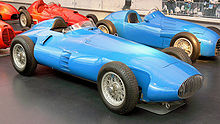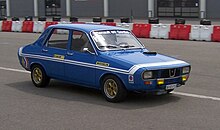Gordini
Gordini was a French Formula 1 racing team, sports car manufacturer and tuner .
The life of an engine tuner
Amédée Gordini , born on June 23, 1899 near Bologna ( Italy ), trained as a car mechanic in his youth . At the age of 14 he worked for the engine manufacturer Isotta Fraschini , where he worked with Alfieri Maserati , among others . At the age of 19 he was already developing and building his first car from Isotta Fraschini parts. In 1925 Gordini, who had meanwhile emigrated to France , specialized in the maintenance and tuning of Fiat automobiles in his workshop in Suresnes . During this time he acquired his nickname "The Witcher", because his skills gave the most varied of engines unimagined additional performance. From the mid-1930s, there was cooperation with the newly founded company Simca , which from 1934 built and sold Fiat models for the French market under license. With financial support from Simca and based on Simca technology, Gordini built a number of sports cars for competition use, whose sporting successes could be used for advertising purposes. Accordingly, these vehicles were called Simca-Gordini .
After the Second World War , Gordini began designing complete racing cars, as a result of which he took part in the Formula 1 World Championship from 1952 to 1956 . He then received an order from Renault to develop a rally car based on the Dauphine. In 1969 Renault incorporated Gordini into the company. During this time the Renault 8 Gordini and the Renault 12 Gordini were created. Amédée Gordini also held a leading position in Renault's motorsport activities. In 1975 Renault officially converted the “Usine Amédée Gordini” in Viry-Châtillon into the Renault Sport department. Amédée Gordini died on May 25, 1979.
The first monoposto
In 1946, just before moving to new factories on the outskirts of Paris , Gordini brought out the first monoposto powered by a 1100 cc Simca engine. In the years that followed, the mechanics continued to develop this type and gradually increased the engine's displacement up to 1430 cm³. Despite the displacement deficit of over 500 cm³, the light and agile Simca-Gordinis with their small frontal area quickly established themselves as the undisputed second force in Formula 2 behind Ferrari . At this time, however, there were initial tensions between Gordini and Simca because Gordini wanted to develop a 2-liter engine that fully complied with the Formula 2 regulations, but Simca did not have a suitable unit as a basis in the program. Instead, a supercharged version of the engine was now available for the 1950 season , making the otherwise unchanged cars compliant with Formula 1 regulations .

The Formula 1 era of Gordinis
For the drivers, however, the Gordini was considered to be an easy-to-set-up and moving vehicle, which, however, was usually denied a better position due to frequent tire and brake defects. Nevertheless, with Robert Manzon 's fourth place at the Grand Prix of Reims , a first respectable success was achieved.
But although a completely new, real Formula 1 engine with a capacity of 1496 cc was developed for 1951 with the Type 16 , there was not a single point to be won in the battle of the giants between Alfa Romeo and Ferrari during the entire season , which Simca took as an opportunity to withdraw from the cooperation with Gordini.
On the one hand, Gordini was no longer tied to the Simca range, on the other hand, he continued to suffer from the scarce financial resources in the development of engines and vehicles. Nevertheless, regular driver Manzon was able to set some highlights with the new 6-cylinder engine in the course of the 1952 season : a third place at the Belgian Grand Prix behind Alberto Ascari and Giuseppe Farina , a fourth place at the French GP and a fifth place at the Grand Prix from Holland, whereby he finished sixth in the final World Cup with nine points. The real star of the team, however, was the up-and-coming talent Jean Behra , who was able to achieve a first podium position for the brand with third place in the first World Championship run in Switzerland. In addition, Behra was also able to win the Formula 2 races in Aix-les-Bains and Reims-Gueux, which are not part of the world championship. And Maurice Trintignant was also able to score points in the World Cup with a fifth place in the French GP.
The 1953 World Cup season , which, as in the previous year, was held according to the Formula 2 regulations, turned into a disaster year for Gordini after promising beginnings: At the inaugural Grand Prix of Buenos Aires , Robert Manzon was despite poor training performances and the Tenth place on the grid after a few failures and thanks to good racing tactics suddenly in the lead for a long time and surprisingly even managed to break away from the field. After a tire change, Alberto Ascari was back in the lead ten laps before the end of the race . Manzon bravely set out to pursue the Italian and was almost within striking distance when, a few kilometers before the finish line, he lost a wheel of his racing car and had to give up. Manzon should have to give up three more times this year in a promising position due to tire defects.
Withdrawal from Formula 1
In view of this disappointment, it was no surprise to anyone in the racing industry that the previous star drivers turned their backs on the team and thus failed to achieve respectable success themselves. Manzon returned later - but without any countable successes. After a total of 35 Grand Prix races and one fastest lap, Gordini withdrew from the Formula 1 circus, as his financial resources did not allow him to compete on an equal footing with the large works teams to be successful in building and tuning rallies - and Sports car working for Renault and Simca .
Life at Renault
When the Gordini company was dissolved in 1968, they had several rally victories in the local world championship on the credit side. Many of Gordini's younger mechanics and engineers were to form the basis of the development team in the late 1970s who built the Renault turbo engine and thus started a new era in Formula 1. On January 1, 1976 René Vuaillat became director of Gordini.
Some sporty Renault models were nicknamed Gordini, such as B. the R8 Gordini, the R12 Gordini or the special model Gordini of the Clio RS.
Models and drivers used in the automobile world championship
| Type | Deployed | driver |
|---|---|---|
| Gordini-Simca-4-cylinder | 1950/51 | Aldo Gordini ; Maurice Trintignant ; Robert Manzon ; André Simon |
| Gordini 6-cylinder T16 | 1952/53 | Jean Behra , M. Trintignant, R. Manzon, Roberto Mières , Bob Biera |
| Gordini 2.5 liters | 1954/56 | J. Behra, R. Manzon, André Pilette , Harry Schell , Élie Bayol , Hernando da Silva Ramos , A. Simon |
| Gordini 8 cylinder T32 | 1955/56 | R. Manzon, A. Pilette, E. Bayol, H. da Silva Ramos, André Guelfi , André Milhoux |
Car
Gordini manufactured some road legal vehicles from 1946. These were convertibles based on Simca.
In addition, individual Gran Turismo models based on racing and racing sports cars were created between the 1950s and 1957 .
literature
- Doug Nye: History of the Grand Prix Car 1945-65 , Hazleton Publishing, Richmond, 1993, ISBN 1-874557-50-0
- Harald H. Linz, Halwart Schrader : The International Automobile Encyclopedia . United Soft Media Verlag, Munich 2008, ISBN 978-3-8032-9876-8 .
- René Bellu: Les voitures françaises des années 50th Editions Jean-Pierre Delville, Paris 1983, ISBN 2-85922-032-1 . (French)
- Roger Gloor: Post War Car. Hallwag Verlag, Bern and Stuttgart 1986, ISBN 3-444-10263-1 .
Web links
- GTÜ Society for Technical Monitoring mbH (accessed on November 26, 2013)
Individual evidence
- ↑ Amédée Gordini's curriculum vitae ( page no longer available , search in web archives ), www.renaultgordini.hu, accessed on February 12, 2011
- ↑ Cléon - RENAULT Association HISTOIRE ( Memento of 26 June 2015, Internet Archive ) sur Association RENAULT HISTOIRE
- ↑ a b Harald H. Linz, Halwart Schrader : The International Automobile Encyclopedia . United Soft Media Verlag, Munich 2008, ISBN 978-3-8032-9876-8 .
- ↑ GTÜ Society for Technical Monitoring mbH (accessed on November 9, 2013)
- ↑ Post-war car from 1945–1960.

